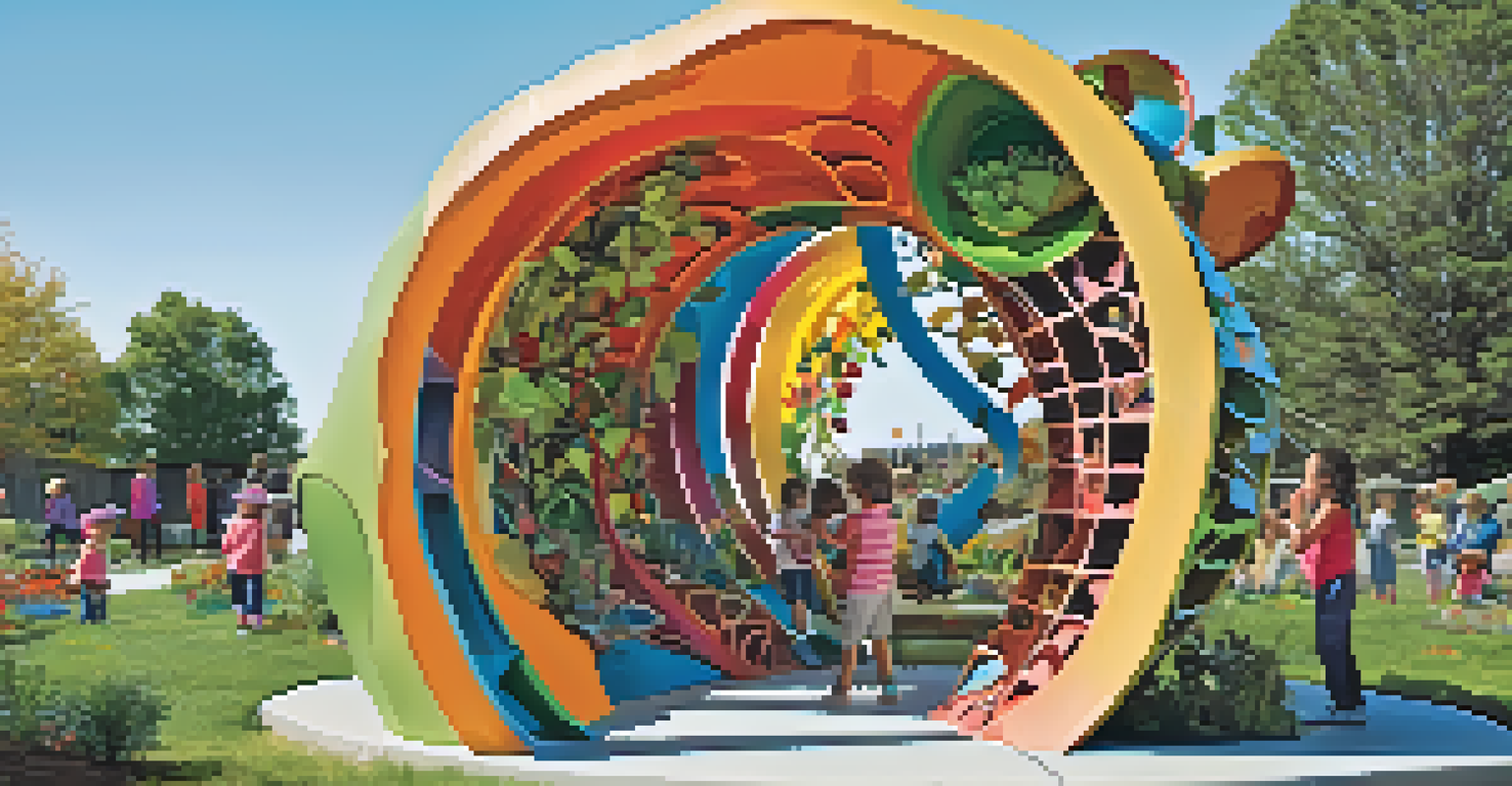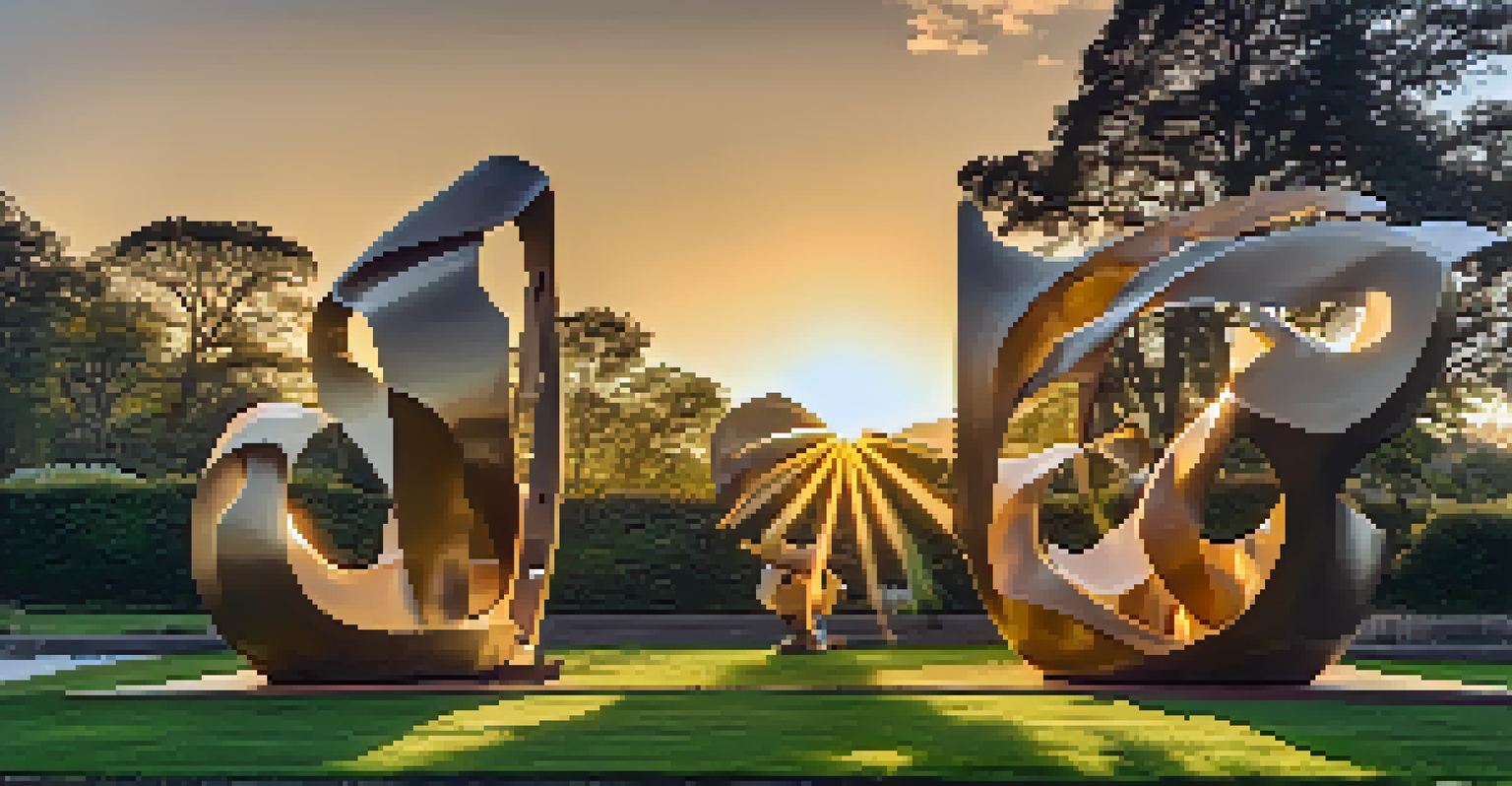Integrating Sculptural Carvings into Landscape Architecture

Understanding the Role of Sculptural Carvings
Sculptural carvings can transform ordinary landscapes into extraordinary experiences. They serve not only as visual focal points but also as storytelling elements that connect people to the environment. For instance, a beautifully carved bench can invite visitors to pause and reflect, enhancing their connection to nature.
Art is not what you see, but what you make others see.
These artistic elements can convey cultural narratives or historical significance, enriching the landscape's meaning. Imagine walking through a park and encountering a stone sculpture that represents the local wildlife; it sparks curiosity and appreciation for the surrounding ecosystem. Such pieces create dialogue and foster community engagement, making spaces feel more alive.
Moreover, sculptural carvings can enhance the aesthetic appeal of a landscape, adding texture and depth. They draw the eye and encourage exploration, inviting visitors to discover hidden details. This integration of art and nature not only beautifies a space but also creates an immersive experience that resonates with people on a deeper level.
Choosing the Right Materials for Sculptural Carvings
Selecting the appropriate materials for sculptural carvings is crucial to their longevity and impact. Common choices include stone, wood, and metal, each offering unique characteristics that can influence the overall aesthetic. For example, granite can convey strength and permanence, while wood might evoke warmth and natural beauty.

Additionally, the local environment should guide material choices. Using local stone or wood can create a sense of place and reduce environmental impact. Imagine a coastal park featuring driftwood sculptures; these elements not only reflect the area’s natural landscape but also resonate with visitors who cherish local culture.
Sculptures Enhance Community Spaces
Sculptural carvings serve as visual focal points that connect people to their environment and foster community engagement.
Durability is another key consideration. Sculptures exposed to the elements must withstand weather conditions, so materials should be chosen accordingly. For instance, metal sculptures can develop a beautiful patina over time, adding character while ensuring resilience. Ultimately, the right material can enhance both the visual and functional aspects of landscape architecture.
Designing Sculptural Carvings with Purpose
When integrating sculptural carvings into landscape architecture, intentional design is crucial. Each carving should serve a clear purpose, whether it’s to beautify, educate, or engage. For example, a sculpture depicting a local animal can inform visitors about the region’s biodiversity, marrying art with education.
The best way to predict the future is to create it.
Moreover, the placement of sculptures is equally important. They should be strategically positioned to enhance sightlines, encourage movement, or create gathering spots. Picture a series of carved stone totems lining a pathway; they can guide visitors through the landscape while inviting them to pause and appreciate each piece.
Lastly, consider the scale of the carvings in relation to the surrounding landscape. A towering sculpture may dominate a small garden, while smaller pieces could be lost in a vast open space. Striking the right balance ensures that each carving complements its environment, creating a harmonious relationship between art and nature.
Incorporating Local Culture into Sculptural Designs
Integrating local culture into sculptural carvings enriches the landscape and fosters community pride. Artists can draw inspiration from local traditions, folklore, or historical events, creating pieces that resonate deeply with residents. For instance, a sculpture representing a significant local event can serve as a reminder of shared history, deepening the community’s connection to the space.
This cultural integration can also attract tourism, as visitors are often drawn to unique, locally-inspired art. Think of a park that features sculptures celebrating indigenous stories; such installations not only honor the culture but also educate visitors, enriching their experience. This dual purpose can create a more inclusive atmosphere where everyone feels represented.
Materials Matter for Durability
Choosing the right materials, such as local stone or wood, is crucial for both the aesthetic appeal and longevity of sculptural carvings.
Engaging local artists in the design process can further enhance authenticity. Their insights and skills can lead to carvings that genuinely reflect the community's identity. By involving local talent, landscape architects can ensure that the sculptures resonate with those who live and work in the area, making the space feel like home.
Creating Interactive Sculptural Experiences
Interactive sculptures invite engagement and participation, creating memorable experiences for visitors. These carvings can be designed to encourage touch, play, or exploration, transforming passive viewers into active participants. For example, a sculpture that doubles as a climbing structure can provide both play and art, catering to families and children.
Such interactions can also foster a sense of ownership and stewardship among the community. When people feel connected to a piece of art, they are more likely to care for the space and advocate for its preservation. Consider a community garden featuring participatory sculptures; these installations can become focal points for gatherings and events, strengthening community bonds.
Moreover, incorporating technology can enhance interactivity. Augmented reality apps can allow visitors to see the story behind each sculpture, adding layers of engagement. Imagine scanning a code next to a carving to reveal its history or the artist’s inspiration; this fusion of art and technology creates a unique experience that captivates diverse audiences.
Sustainability in Sculptural Carving Practices
Sustainability is an essential consideration in the integration of sculptural carvings into landscape architecture. Artists and designers should prioritize eco-friendly materials and practices that minimize environmental impact. For example, using reclaimed wood or recycled metals not only reduces waste but also adds unique character to the sculptures.
Moreover, sustainable practices extend to the creation process as well. Employing local artisans can lower transportation emissions and foster community relationships. When local artists create sculptures from locally sourced materials, it promotes a cycle of sustainability that benefits both the environment and the economy.
Integrating Local Culture is Key
Incorporating local cultural elements into sculptural designs enriches the landscape and strengthens community pride.
Additionally, incorporating native plants around sculptural installations can enhance biodiversity and support local wildlife. By creating a harmonious relationship between art and the surrounding ecosystem, landscape architects can ensure that their designs are not only beautiful but also environmentally responsible.
Case Studies: Successful Integration of Sculptural Carvings
Several successful projects illustrate the effective integration of sculptural carvings into landscape architecture. For example, the High Line in New York City features a variety of sculptures that complement the park's urban environment while enhancing the visitor experience. These pieces not only provide visual interest but also encourage exploration and interaction.
Similarly, the Storm King Art Center in New York showcases large-scale sculptures set against a stunning natural backdrop. This integration of art and landscape invites visitors to wander and contemplate, allowing the sculptures to engage with the surrounding environment. Each piece tells a story, contributing to a cohesive narrative that enhances the overall experience.

These case studies highlight the potential of sculptural carvings to elevate landscapes. By thoughtfully considering design, materials, and community engagement, landscape architects can create spaces that are not only aesthetically pleasing but also meaningful and impactful.